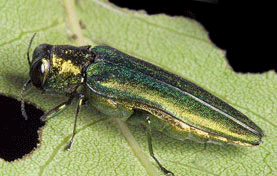FAIRFIELD – Just last month, officials announced that Emerald Ash Borer, an invasive beetle that destroys ash trees, was found in Burlington. Now comes confirmation of an infestation in Fairfield.
Local information about Emerald Ash Borer can be found on the Trees Forever website.
Iowa agencies released the following today, Aug. 1, 2013:
Emerald Ash Borer (EAB) has been positively identified in a residential tree in the city of Fairfield in Jefferson County, making this the third location where the invasive beetle has been found in Iowa. Allamakee County was declared infested in May 2010 and Des Moines County in July 2013.
EAB kills all ash species and is considered to be one of the most destructive tree pests ever seen in North America.
With this new find close to the Des Moines County infestation, State Entomologist Robin Pruisner said the Iowa Department of Agriculture and Land Stewardship (IDALS), along with the United States Department of Agriculture (USDA), will be issuing a multicounty quarantine in southeast Iowa in the near future. This regulatory action restricts movement of hardwood firewood, ash logs and wood chips out of the quarantined counties.
Pruisner said all Iowans are strongly cautioned not to transport firewood across county or state lines, since the movement of firewood throughout Iowa or to other states poses the greatest threat to quickly spread EAB even further. Most EAB infestations in the United States have been started by people unknowingly moving infested firewood, nursery plants or sawmill logs. The adult beetle also can fly short distances, approximately 2 to 5 miles.
The current EAB infestation was found as a result of survey efforts by the Iowa EAB Team. This team includes officials from IDALS, Iowa State University Extension and Outreach, the Iowa Department of Natural Resources, USDA Animal Plant Health Inspection Service and the USDA Forest Service.
“Preventive treatments next spring — mid-April to mid-May 2014 — are suggested to protect vigorously healthy and valuable ash trees within 15 miles of the known infested area,” said ISU Extension and Outreach Entomologist Mark Shour. For more details, see ISU Extension and Outreach publication PM2084, www.extension.iastate.edu/Publications/PM2084.pdf<http://www.extension.iastate.edu/Publications/PM2084.pdf>.
Ash is one of the most abundant native tree species in North America, and has been heavily planted as a landscape tree in yards and other urban areas. According to the USDA Forest Service, Iowa has an estimated 52 million rural ash trees and approximately 3.1 million more ash trees in urban areas. It is unknown how many public and residential ash trees are located in Fairfield.
To learn more about EAB and other pests that are threatening Iowa’s tree population, please visit www.IowaTreePests.com<http://www.iowatreepests.com/>. Or, for more information contact any of the following members of the Iowa EAB Team:
§ Robin Pruisner, State Entomologist, 515-725-1470, Robin.Pruisner@IowaAgriculture.gov<mailto:Robin.Pruisner@IowaAgriculture.gov>
§ Tivon Feeley, DNR Forest Health Coordinator, 515-281-4915, Tivon.feeley@dnr.iowa.gov<mailto:Tivon.feeley@dnr.iowa.gov>
§ Emma Hanigan, DNR Urban Forest Coordinator, 515-281-5600, emma.hanigan@dnr.iowa.gov<mailto:emma.hanigan@dnr.iowa.gov>
§ Jesse Randall, ISU Extension Forester, 515-294-1168, Randallj@iastate.edu<mailto:Randallj@iastate.edu>
§ Mark Shour, ISU Extension Entomologist, 515-294-5963, mshour@iastate.edu<mailto:mshour@iastate.edu>
§ Laura Jesse, ISU Extension Entomologist, ISU Plant and Insect Diagnostic Clinic, 515-294-0581, ljesse@iastate.edu<mailto:ljesse@iastate.edu>
§ Donald Lewis, ISU Extension Entomologist, 515-294-1101, drlewis@iastate.edu<mailto:drlewis@iastate.edu>.
§ Jeff Iles, ISU Extension Horticulturist, 515-294-3718, iles@iastate.edu<mailto:iles@iastate.edu>


No Comments Yet